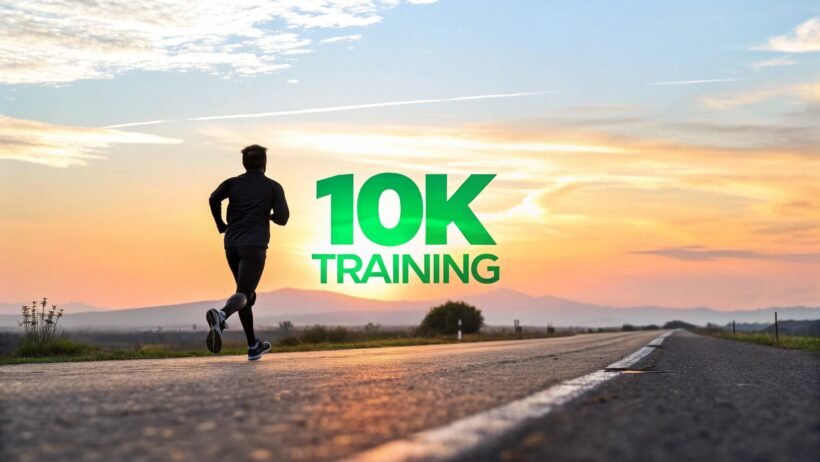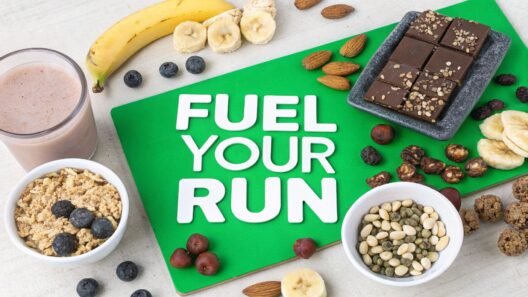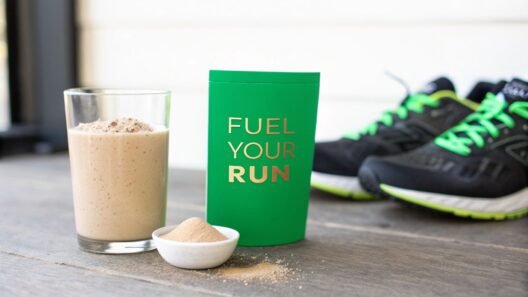So, you're thinking about running a 10K. The big question is, just how far is it?
The straightforward answer is 10 kilometers, which works out to be exactly 6.2 miles. But that simple number doesn't quite capture the full story. The 10K has become one of the most popular race distances on the planet because it hits a sweet spot for runners of all stripes.
How Far Is a 10K in Miles and Kilometers?
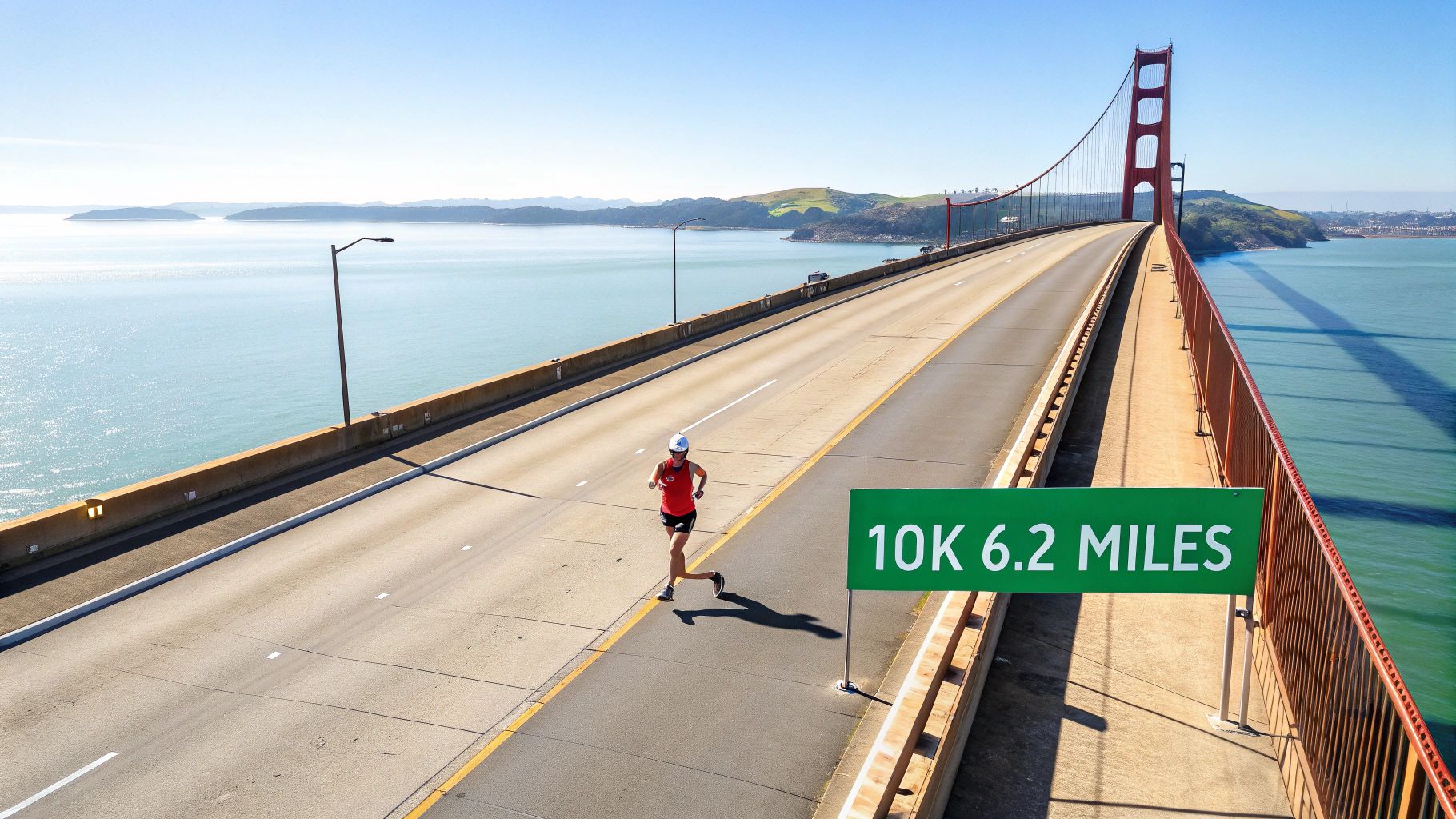
For a lot of runners, the 10K is the perfect middle ground. It’s a serious jump from the more common 5K (which is 3.1 miles), so it demands a real boost in endurance and mental toughness. At the same time, it doesn't require the massive, time-intensive training commitment that a half or full marathon does.
This makes it a fantastic goal for new runners who have a 5K under their belt and are looking for the next challenge. It's also a go-to for seasoned runners who want to sharpen their speed for a longer race. It's a distance that will absolutely test your fitness without totally consuming your life.
Putting the Distance into Perspective
Numbers on a page are one thing, but picturing what 6.2 miles actually feels like is something else entirely. It’s a solid effort. To give you a better idea, imagine running across the famous Golden Gate Bridge and back—and then doing it again. That’s roughly the effort of a 10K.
A 10K is more than just a number; it's a milestone. For many, completing that first 10K is the moment they go from being a casual jogger to a dedicated runner who truly understands pacing, endurance, and training.
Think about it another way: a standard athletics track is 400 meters around. To run a 10K on a track, you'd have to circle it 25 times. That really drives home the kind of sustained effort needed to get to the finish line. It's a journey that takes you far beyond a quick jog around the block.
Understanding the 10K Distance at a Glance
To help you really wrap your head around the scale of a 10K, this table breaks down the distance into different units and provides a few more real-world comparisons.
| Unit | Distance | Real-World Comparison |
|---|---|---|
| Kilometers | 10 km | The official distance and name of the race. |
| Miles | 6.21 miles | The imperial equivalent, commonly used in the US. |
| Meters | 10,000 m | Perfect for track athletes who measure in meters. |
| Track Laps | 25 laps | Highlights the endurance needed for the distance. |
Seeing the numbers laid out like this helps clarify the challenge ahead. Whether you think in miles, kilometers, or even track laps, a 10K is a significant and rewarding achievement.
Why Millions of Runners Choose the 10K
https://www.youtube.com/embed/gypaBvonL5o
The 10K isn't just a number on a race bib; it's a global phenomenon. It has this unique magnetic pull that attracts runners from every walk of life, from those lacing up for their first serious race to elite athletes pushing their physiological limits. But what is it about this specific distance that makes it so universally appealing?
At its heart, the 10K is the perfect "bridge" distance in the running world. It’s a serious step up from the ever-popular 5K, demanding a bigger commitment to training and building endurance. At the same time, it’s still incredibly accessible and doesn't require the same life-altering preparation that a half or full marathon does. This perfect balance makes it an ideal milestone for so many.
This unique positioning is why the 10K, which is 6.2 miles, has become one of the planet's most popular race distances. Each year, roughly 2 million people participate in about 3,500 organized 10K events around the globe. Those numbers speak for themselves, highlighting its role as a challenging yet achievable goal for a massive community of runners. You can explore more about the 10K’s global appeal and what makes it such a staple in the running world.
The Sweet Spot of Challenge and Achievement
For many people, finishing a 10K is the moment they truly start to feel like a "runner." It demands a strategic approach to pacing and saving energy in a way that a 5K doesn't always require. You can't just sprint from the starting line; you have to learn to listen to your body and manage your effort over a much longer period.
This mix of speed and stamina is exactly what makes it such a satisfying accomplishment. Crossing that finish line proves you have both the physical endurance and the mental grit to push through discomfort and hit a tough goal.
The 10K is where strategy meets endurance. It’s long enough to demand respect and smart pacing, but short enough that the finish line always feels within reach. This makes it an incredibly empowering experience for runners at every level.
A Benchmark for Every Runner
Another key to the 10K's popularity is its sheer versatility. It serves different purposes for different athletes, making it a universal benchmark for fitness and performance.
- For Beginners: It's the logical next step after conquering the 5K. It offers a new, exciting challenge that builds both confidence and endurance.
- For Intermediate Runners: It’s a fantastic distance for focusing on speed. Many runners set their sights on personal records, like the celebrated milestone of finishing in under an hour.
- For Advanced Athletes: The 10K is a crucial performance test. Marathoners often use it as a "sharpener" race to gauge their fitness and practice race-day intensity without needing a long recovery.
Whether it’s a massive city-wide race with thousands of participants or a small local charity run, the 10K provides a shared experience. It's a distance that unites the running community, offering common ground for celebration, competition, and personal growth—no matter what your pace is.
Setting a Realistic 10K Finish Time Goal
So, what’s a "good" 10K time? It's one of the first questions every runner asks, and the honest-to-goodness answer is: it completely depends on you.
A respectable time for a seasoned pro is a world apart from a monumental achievement for a first-timer. The best goal is always personal. It should be something that genuinely motivates you and feels achievable based on where you are right now in your running journey.
Instead of getting hung up on a generic number, let's look at what different finish times actually mean for runners at various stages. This will help you set a target that makes sense for you.
Benchmarks for Every Runner
Your running experience is the biggest piece of the puzzle when setting a realistic goal. Someone lacing up for their very first race has a much different objective than a runner who has been competing for years.
Here’s a general breakdown of what different time goals tend to represent:
- Beginner Runners (Finishing Comfortably): If you're new to this distance, the main goal is often just to cross that finish line feeling strong and proud. A time between 1 hour 15 minutes and 1 hour 30 minutes is a fantastic accomplishment. It proves you have the endurance to cover all 6.2 miles.
- Intermediate Runners (Breaking the Hour): For runners with a few races under their belt, breaking the 60-minute mark is a classic milestone. Hitting this target requires holding a consistent pace around 9:40 per mile and shows a real jump in your fitness.
- Advanced Runners (Racing Competitively): More seasoned runners often start pushing to finish somewhere between 40 and 50 minutes. This level of performance requires dedicated training, a solid dose of speed work, and a smart race-day strategy.
Finding Your Pace and Target Time
To set a goal you can actually achieve, you need to understand pace. A great starting point is to look at your current fitness. If you can comfortably run a 5K, that time is a great indicator of what you might be able to do in a 10K. From there, you can work backward to figure out the average pace per mile or kilometer you'll need to maintain.
A goal should stretch you, not break you. The best 10K finish time is one that challenges you to train consistently but remains within reach, turning your hard work into a rewarding finish-line celebration.
To take the guesswork out of it, an online tool can do the math for you. Our free pace calculator for runners is perfect for figuring out the exact pace you'll need to hold to hit your dream finish time.
Average 10K Finish Times by Skill Level and Pace
To give you an even clearer picture, the table below breaks down common 10K finish times alongside the average pace required to achieve them. See where you might fit in and use it as a starting point for setting your own personal goal.
| Skill Level | Average Finish Time | Average Pace (per mile) | Average Pace (per km) |
|---|---|---|---|
| Beginner / First-Timer | 1:15:00 – 1:30:00 | 12:05 – 14:30 | 7:30 – 9:00 |
| Novice Runner | 1:00:00 – 1:15:00 | 9:40 – 12:05 | 6:00 – 7:30 |
| Intermediate Runner | 50:00 – 1:00:00 | 8:03 – 9:40 | 5:00 – 6:00 |
| Advanced Runner | 40:00 – 50:00 | 6:26 – 8:03 | 4:00 – 5:00 |
| Elite Runner | Under 40:00 | Under 6:26 | Under 4:00 |
At the end of the day, your race is your own. Whether you finish in 45 minutes or 90, completing a 10K is a major accomplishment that’s absolutely worth celebrating.
Your First 8-Week 10K Training Plan
So, you've got your sights set on the 10K finish line. Fantastic! Now comes the fun part: building the roadmap to get you there. The single best thing you can do for yourself is to commit to a training plan. It removes all the guesswork, helps you build up your endurance safely, and keeps you from doing too much, too soon.
This simple 8-week plan is perfect for beginners. The whole idea is to gradually increase your running time, which is the key to minimizing the risk of injury. We'll focus on three core running days a week, mixed in with some other activities and—most importantly—rest. This balanced approach is what builds real fitness without burning you out.
The Building Blocks of Your Training
Your weekly schedule will be a mix of a few different types of workouts. Once you understand why you're doing each one, it's much easier to stay motivated and train smart.
- Easy Runs: Think of these as runs where you can hold a conversation without gasping for air. The goal isn't speed; it's about building up your aerobic base, which is the foundation of all your running.
- Run/Walk Intervals: This is the secret weapon, especially in the first few weeks. Alternating between running and walking is an incredibly effective way to cover more ground without completely trashing your body.
- Cross-Training: Don't just run! Activities like swimming, cycling, or even a good strength training session build up all the supporting muscles that running neglects. This helps prevent burnout and keeps injuries at bay. Try to get one or two sessions in each week.
- Rest Days: These are absolutely non-negotiable. Your body doesn't get stronger during the run; it gets stronger when it's recovering afterward. Skipping rest days is one of the fastest ways to get injured or stall your progress.
A Sample 8-Week Schedule
Think of this plan as a template. Feel free to shuffle the days around to fit your life, but try your best to stick to the overall structure. If you feel like 8 weeks is a bit too quick, you can always check out our 12-week 10K training plan for a more gradual approach.
| Week | Day 1 (Run) | Day 2 (Cross-Train) | Day 3 (Run) | Day 4 (Run) |
|---|---|---|---|---|
| 1 | Run 1 min / Walk 1 min (x10) | 30 min easy | Run 1 min / Walk 1 min (x10) | Run 1.5 miles |
| 2 | Run 2 min / Walk 1 min (x7) | 30 min easy | Run 2 min / Walk 1 min (x8) | Run 2 miles |
| 3 | Run 5 min / Walk 1 min (x4) | 30-40 min | Run 5 min / Walk 1 min (x5) | Run 2.5 miles |
| 4 | Run 8 min / Walk 1 min (x3) | 30-40 min | Run 10 min / Walk 1 min (x2) | Run 3 miles |
| 5 | Run 2.5 miles | 40 min easy | Run 20 minutes | Run 3.5 miles |
| 6 | Run 3 miles | 40 min easy | Run 25 minutes | Run 4 miles |
| 7 | Run 3.5 miles | 30 min easy | Run 20 minutes | Run 5 miles |
| 8 | Run 2 miles (easy) | Rest | Race Day! | Celebrate! |
When you toe that starting line, you're becoming part of a massive global movement. Running has absolutely exploded in popularity, with participation jumping by about 57% worldwide over the last ten years. It just goes to show how many people are looking for accessible and empowering goals—just like the one you've set for yourself.
This chart is a great visual for how runners tend to progress, showing how finish times get faster as experience grows.
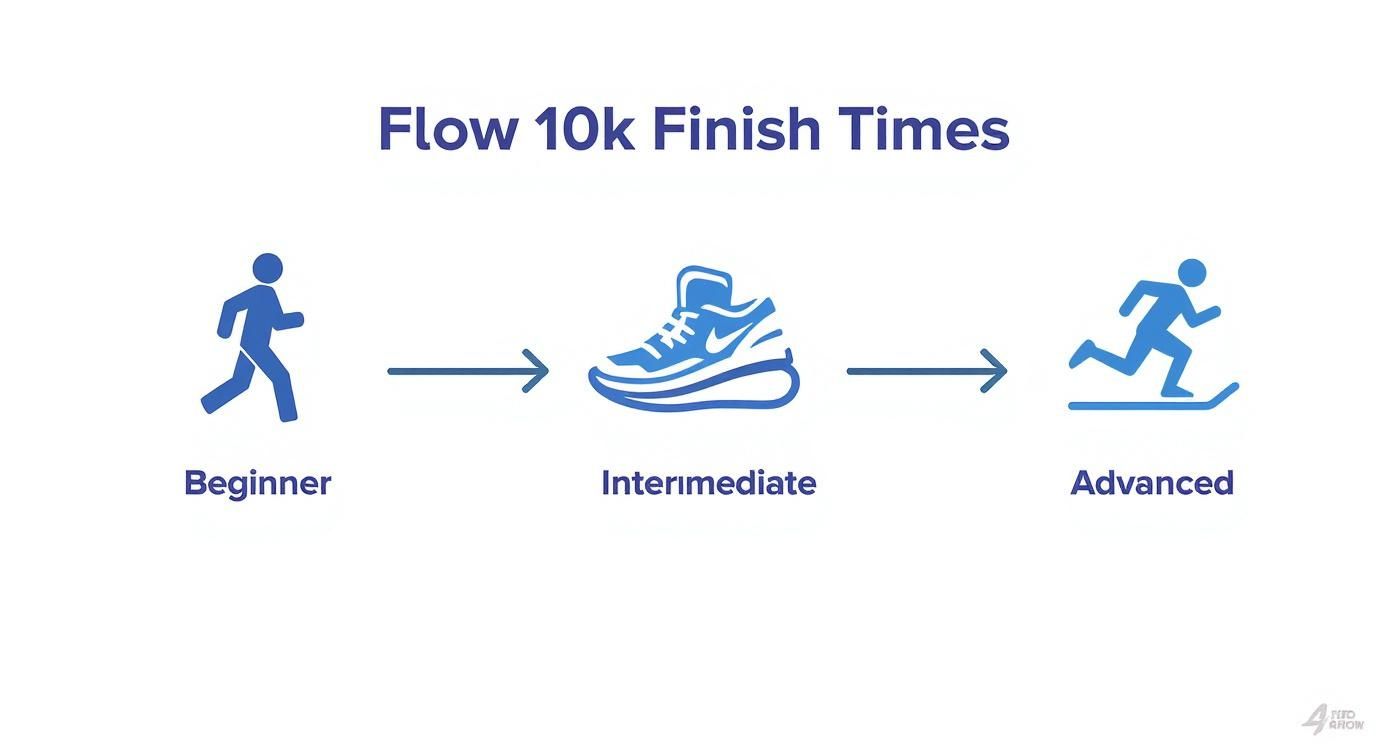
As you can see, consistent training is what turns a nervous first-timer into a confident, seasoned racer. It’s all about putting in the work.
Remember: The real goal here isn't just to drag yourself across the finish line. It's to arrive at the starting line feeling healthy, prepared, and genuinely confident. Listen to your body, celebrate the small wins along the way, and trust the process. You've got this.
Essential Tips for a Successful Race Day
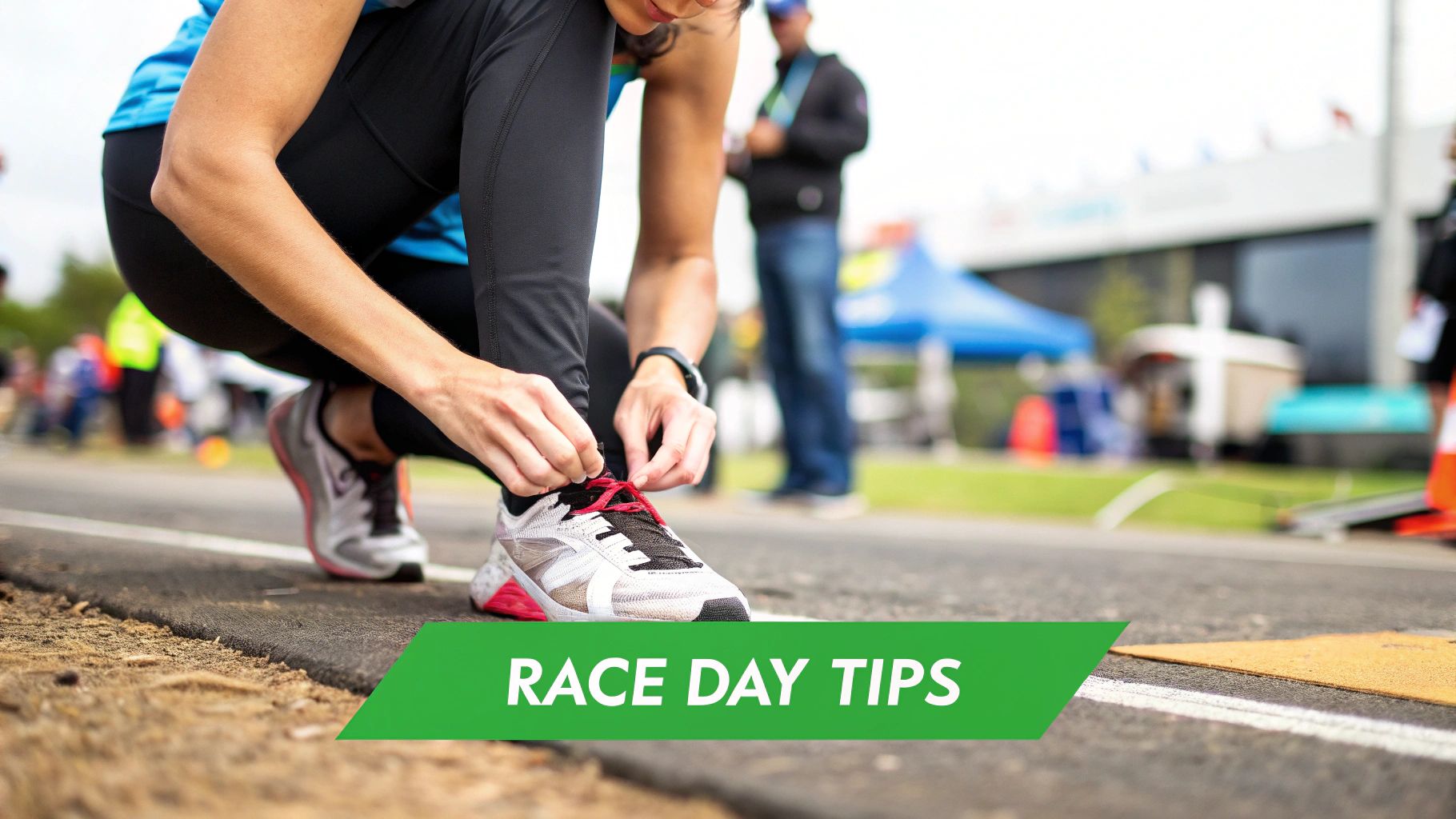
After all those weeks of training, race day finally feels like a victory lap. The heavy lifting is over. Now, it's all about putting your plan into action and, most importantly, enjoying the ride. A great race day performance isn't just about your fitness—it's about nailing the small details that make a huge difference.
If there's one golden rule for race day, it's this: nothing new. This goes for everything—your gear, your breakfast, and your race strategy. You should be wearing the same shoes, socks, and outfit that you’ve already logged plenty of comfortable miles in. A brand-new shirt or pair of shorts is a classic rookie mistake that can easily lead to surprise blisters or chafing.
Fueling Your Body for the 10K
Getting your nutrition right is the bedrock of a strong race, and that process really begins the night before. Focus on a simple, familiar meal packed with carbohydrates to make sure your energy stores are full. Think pasta, rice, or potatoes. Just be sure to steer clear of anything too fatty, spicy, or high in fiber, which can cause trouble later.
On the morning of the race, aim to eat a light, easy-to-digest breakfast about 2-3 hours before the gun goes off. A piece of toast with peanut butter, a banana, or a small bowl of oatmeal are all fantastic choices. This timing gives your body a chance to absorb the energy without leaving you feeling full or sluggish. If you need more inspiration, our guide on what to eat before a run has tons of simple, effective ideas.
Hydration is just as crucial. Keep sipping water throughout the morning, but don’t chug it. The idea is to be properly hydrated, not sloshing your way to the starting line.
Your race-day strategy is about trusting your training. You’ve prepared your body for the 6.2 miles; now, the main goal is to manage your energy, stay calm, and let that preparation shine through.
Pacing and Mental Preparation
One of the biggest traps nearly every runner falls into at some point is starting out way too fast. The adrenaline is pumping, the crowd is buzzing, and it's incredibly easy to get swept up in the excitement. The best way to combat this is to go in with a clear pacing plan.
- First Mile: Make a conscious effort to run this mile slower than your goal pace. Think of it as your final warm-up, allowing your body to settle into a comfortable rhythm.
- Miles 2-5: This is the heart of the race. Lock into your target pace and focus on running strong and controlled. You should feel like you're working, but not struggling.
- Final 1.2 Miles: With the finish line practically in view, now’s the time to dig deep. If you’ve got energy left in the tank, you can start to gradually pick up the pace and finish strong.
It's also important to prepare yourself mentally. A 10K is a genuine challenge, and you're going to hit a few rough patches. When you do, try breaking the race down into smaller, more digestible pieces. Instead of getting overwhelmed by the full 6.2 miles, just focus on making it to the next water station or the next kilometer marker.
And finally, don't forget to enjoy yourself. Soak in the energy from the crowd, give a high-five to a spectator, and flash a smile for the race photographers. You earned this
Still Have Questions About Running a 10K?
As race day gets closer, it's totally normal for a few questions to start bouncing around in your head. Getting them answered ahead of time is a huge confidence booster and helps quiet those pre-race jitters. Let's tackle some of the most common ones I hear from new runners.
Is It Okay to Walk During a 10K?
Absolutely! In fact, it’s often a smart strategy. Many people go into their first 10K with a planned run-walk approach, and plenty of folks walk the entire 6.2 miles. Most 10K events are built to be inclusive, with generous cutoff times that welcome all paces.
For your first race, the real goal is just to get out there and cross that finish line. Walking is a fantastic way to make that happen. Don't ever feel pressured to run every single step if that's not your plan.
What Kind of Shoes Do I Need for a 10K?
You definitely don't need top-of-the-line racing shoes, but a solid pair of dedicated running shoes is non-negotiable. This is probably the most important investment you'll make. The right shoes give you the cushioning and support to prevent aches, pains, and injuries throughout your training.
Your best bet? Go to a specialty running store. The staff there know their stuff. They can watch you walk or run, analyze your gait, and recommend a shoe that’s built for your specific needs. Trying to train in old sneakers or shoes made for another sport is just asking for trouble.
"A 10K is more than just double the distance of two 5Ks; it's a greater test of endurance and pacing. Learning to conserve energy in the early miles is the key to finishing strong."
How Is a 10K Different From Two 5Ks?
The math might be simple, but the experience is a world apart. Running a 10K demands a much bigger reservoir of endurance and a smarter, more conservative pacing plan. In a 5K, you can often get away with pushing hard right from the gun.
Try that in a 10K, and you'll likely hit the wall well before the finish. The real challenge is learning to hold back and conserve your energy in the first half so you have something left in the tank to finish strong. It’s a true test of balancing speed with stamina.
Do I Need Energy Gels for a 10K?
For most runners, the answer is no. A 10K is short enough that you can typically get through it without needing to take on mid-race fuel like gels. If you’ve eaten a good pre-race meal, your body has enough stored energy (glycogen) to power you for well over an hour of running.
Hydration, however, is a different story. It’s crucial. Make a point to grab a few sips of water at the aid stations along the course, especially on a warm day. You don’t need to chug a whole cup—just enough to stay hydrated without feeling sloshy. The 10K is an incredibly popular distance, drawing a huge variety of people. In fact, a major analysis of over a million U.S. finishers showed a nearly even split between genders, with 49.5% women and 46.8% men. You can dig into more stats in this study on 10K race participation trends.
At THE RUNNING, we provide the expert guides and training plans you need to conquer your first 10K and beyond. Visit us today to start your journey.



